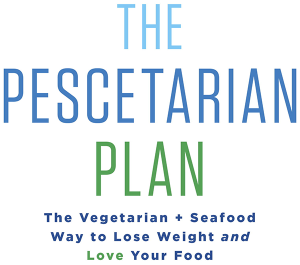Eat fish and you’ll protect your heart, plus you’ll stay smarter and happier and— no joke— have a better sex life. Go vegetarian and you’ll be thinner, dramatically reduce your risk of developing heart disease and cancer, and live longer. But why not have it all? You can! Just combine the two eating styles and become a pescetarian; it’s a vegetarian diet with the addition of seafood (the word pescetarian comes from pesce, the Italian word for fish).
Being a pescetarian is easy, delicious, wildly healthy, and slimming.
- Easy in that you can eat nearly any food on the planet—just avoid poultry or meat. When you go out to eat, are on vacation, at a coffee shop, even at a convenience store (yogurt and nuts anyone?) you’ll find food that’s on The Pescetarian Plan.
- Delicious because the sky’s the limit when it comes to the types of foods you can eat on this plan—Italian, Indian, Asian, American—whatever! Best of all, you can eat what you like, and if you like poultry and meat, there are plenty of super-tasty pescetarian substitutes, like salmon burgers instead of beef burgers or barbequed shrimp instead of chicken wings.
You’ll find lots of great recipes—most take under 25 minutes to make—in our book The Pescetarian Plan. My co-author, chef Sidra Forman ingeniously marries “healthy” with “delicious”.
- Wildly healthy (no exaggeration) because populations who eat this way have astonishingly low risk of diseases like heart disease, cancer, type 2 diabetes and dementia. Bold claims, but as you’ll read in The Pescetarian Plan, all backed up by science.
How does this diet deliver such profound health benefits? Fish plays a big role—its omega-3 fats fight inflammation, which is a cause of heart disease, cancer, type 2 diabetes, and many other diseases that plague Americans and people living all over the world. And thanks to fish and plant sources of omega-3s, The Pescetarian Plan delivers equal amounts of omega-3 and omega-6 fats. That huge when it comes to your health: in the typical American diet, omega-6 outnumbers omega-3 by 16 to 1 or more. The result: inflammation, disease, premature death. In addition to omega-3s, this diet also protects your health with a wide range of vitamins, minerals and phytonutrients courtesy of fruit, vegetables and whole grains.
On The Pescetarian Plan we show you how to take in more omega-3 fats from fish, walnuts, chia and flaxseeds and fewer omega-6s (found in soybean oil, corn oil and the like). And olive oil, made up mainly of monounsaturated fat—another healthy one—is the primary oil on this plan.
- Slimming because this way of eating fills you up on fewer calories. Pescetarians are, on average, about 20 pounds lighter than regular eaters, according to a study tracking 89,000 Seventh- day Adventists in the United States and Canada. Adventists are an ideal group to study because their religion advocates a vegetarian diet (only about half are actually vegetarians, while another 10 percent are pescetarians; the rest are “regular eaters,” eating meat, poultry, and everything else).
If you need to lose weight, The Pescetarian Plan gives clear guidance on sticking with a 1,500, 1,800, 2,200 and 2,500 calorie diet, with lots and lots of flexibility. You can follow the “Seven Pescetarian Principles” and do it yourself, creating your own meals. Or, follow the tasty and easy meal plans. (Or do both—start out with the meal plans and then go off on your own.)
Here’s to your health—and taste buds!
–Janis Jibrin, RD
